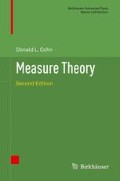Abstract
In Chapter 3 we look in some detail at the convergence of sequences of functions. In Section 3.1 we define convergence in measure and convergence in mean, and we compare those modes of convergence with pointwise and almost everywhere convergence. In Section 3.2 we recall the definitions of norms and seminorms on vector spaces, and in Sections 3.3 and 3.4 we apply these concepts to the study of vector spaces of functions with integrable pth powers and to convergence in these spaces. Finally, in Section 3.5 we begin to look at dual spaces (the spaces of continuous linear functionals on normed vector spaces). We will continue the study of dual spaces in Sections 4.5, 7.3, and 7.5, by which time we will have developed enough tools to analyze and characterize a number of standard dual spaces.
Access this chapter
Tax calculation will be finalised at checkout
Purchases are for personal use only
Notes
- 1.
We can verify our results in the case of \([-\infty, +\infty ]\)-valued functions that are finite almost everywhere by choosing a μ-null set N such that the functions f and f 1, f 2, … are all finite outside N and then replacing f and f 1, f 2, … with the functions g and g 1, g 2, … defined by \(g = f\chi _{{N}^{c}}\) and \(g_{n} = f_{n}\chi _{{N}^{c}}\). This enables us to avoid the complications caused by expressions like f n (x) − f(x) when f n (x) or f(x) is infinite.
- 2.
Convergence with respect to a semimetric or a seminorm is defined in the same way as convergence with respect to a metric or a norm. Note, however, that a sequence that is convergent with respect to a semimetric or a seminorm might have several limits.
- 3.
- 4.
Actually, the norm here and in the following paragraph is the norm from Example 3.2.1(f). We can’t say that it is the norm from C[a, b] until we show that f is continuous.
- 5.
An inner product on a complex vector space V is a complex-valued function ( ⋅, ⋅) on V ×V that satisfies (i), (ii), (iv), and \((x,y) = \overline{(y,x)}\) for all x, y, z in V and all α, β in \(\mathbb{C}\). In this book we will deal with inner products only on real vector spaces.
- 6.
Some authors define \({\mathcal{L}}^{\infty }(X,\mathcal{A},\mu, \mathbb{R})\) and \({\mathcal{L}}^{\infty }(X,\mathcal{A},\mu, \mathbb{C})\) to consist of functions f that are essentially bounded, which means that there is a nonnegative number M such that \(\{x \in X : \vert f(x)\vert > M\}\) is locally μ-null (locally null sets are defined a bit later in this section). For most purposes, it does not matter which definition of \({\mathcal{L}}^{\infty }\) one uses. However, for the study of liftings (see Appendix F), the definition given here is the more convenient one.
- 7.
We use locally null sets, rather than null sets, here and in the construction of the L ∞ spaces given below in order to make Proposition 3.5.5, Theorem 7.5.4, and Theorem 9.4.8 true.
- 8.
Equivalently, for each f in \({\mathcal{L}}^{p}(X,\mathcal{A},\mu )\) the coset to which f belongs is the set \(f + {\mathcal{N}}^{p}(X,\mathcal{A},\mu )\) and hence the set \(\{f + g : g \in {\mathcal{N}}^{p}(X,\mathcal{A},\mu )\}\).
- 9.
When dealing with the complex L p spaces, let each d j be a complex number whose real and imaginary parts are rational.
- 10.
The function f is called nonnegative if f(x) ≥ 0 holds at each x in [a, b].
- 11.
The usefulness of these results seems to be attributable to two facts:
-
(a)
If a linear functional on a space of functions can be represented as an integral, then the limit theorems of Sect. 2.4 are applicable.
-
(b)
The methods available for decomposing and analyzing measures are often easier to visualize than those that apply directly to linear functionals.
-
(a)
- 12.
We are here assuming that the space X is not locally null. If X is locally null, then \({L}^{1}(X,\mathcal{A},\mu )\) and \({L}^{\infty }(X,\mathcal{A},\mu )\) contain only 0, and the proposition is true (but uninteresting).
References
Gleason, A.M.: Fundamentals of Abstract Analysis. Addison-Wesley, Reading (1966). Reprinted by A.K. Peters, 1992
Hoffman, K.: Analysis in Euclidean Space. Prentice-Hall, Englewood Cliffs (1975). Reprinted by Dover, 2007
Kolmogorov, A.N., Fomin, S.V.: Introductory Real Analysis. Prentice-Hall, Englewood Cliffs (1970). Reprinted by Dover, 1975
Rudin, W.: Principles of Mathematical Analysis, 3rd edn. McGraw-Hill, New York (1976)
Simmons, G.F.: Introduction to Topology and Modern Analysis. McGraw-Hill, New York (1963)
Thomson, B.S., Bruckner, J.B., Bruckner, A.M.: Elementary Real Analysis, 2nd edn. ClassicalRealAnalysis.com (2008)
Walter, W.: A counterexample in connection with Egorov’s theorem. Amer. Math. Monthly 84, 118–119 (1977)
Author information
Authors and Affiliations
Rights and permissions
Copyright information
© 2013 Springer Science+Business Media New York
About this chapter
Cite this chapter
Cohn, D.L. (2013). Convergence. In: Measure Theory. Birkhäuser Advanced Texts Basler Lehrbücher. Birkhäuser, New York, NY. https://doi.org/10.1007/978-1-4614-6956-8_3
Download citation
DOI: https://doi.org/10.1007/978-1-4614-6956-8_3
Published:
Publisher Name: Birkhäuser, New York, NY
Print ISBN: 978-1-4614-6955-1
Online ISBN: 978-1-4614-6956-8
eBook Packages: Mathematics and StatisticsMathematics and Statistics (R0)

